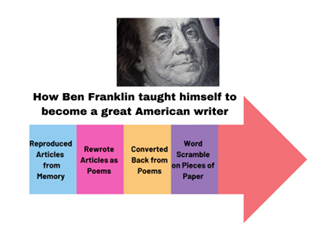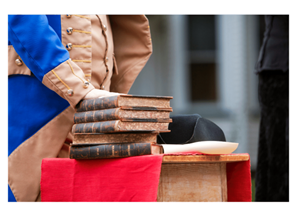
Ben Franklin Case Study – Reading

Reading time: 10 minutes
Learn How You Can Study Smarter
We know Ben Franklin and a founding father of our nation. He was also a scientist, inventor, diplomat, publisher, and writer whose words are still widely read more than two centuries later. And we may know he became one of the most admired writers of early America.
| But did you know he started as only a mediocre writer? Let’s learn how he taught himself to become a great writer! Look for some good ideas in this reading you can practice at home. |
This is a true story about his efforts to learn how to become a much better writer. Ben had to figure out how to learn by himself since he lived in a time where he didn’t have access to a local college, and the internet did not exist for another 200 years.
His efforts as a self-learner provide us with a powerful example of how we can become better learners! Read this to learn how Franklin solved his problem with some unique solutions – using learning strategies that are valid today. These practices support effective methods you can learn to do by yourself!
Save this document to use as a reading with your kids. Then use your Instructor’s Guide to teach a fun mini-lesson on smarter learning practices and to start great a conversation on how you can improve how you study at home.
How this Case Works
This case will help you teach your kid this important principle about learning:
- we learn best when we create “desirable difficulties” for ourselves.
Comfortable learning should not be your goal – it is not as effective as the study you design to make your brain work a little harder. Use this reading with the instructor’s guide to make these important points:
- When we plan our studies or training sessions to push ourselves a little harder, we will learn more and faster. Learn more in less time is your goal.
- Most students fall into the trap of making their learning comfortably like an old shoe. They don’t understand that our brains can be compared to a muscle – it grows when it is pushed a little harder.
- If you want to become very good at something, structure your practicing and studying to keep you slightly outside your comfort zone.
You do this by progressively and intentionally modifying your learning activities to slightly increase the degree of difficulty as you are improving your skills.
In this case, you will learn how Ben Franklin used what we now call desirable difficulties to become one of our most famous American writers.
Read this story together and talk about it! Note how Ben Franklin changed his learning strategies four times to push himself harder while he learned and practiced becoming a great American writer.
To get a free copy of your Instructor’s Guide for this case, click on this link Ben Franklin Case Study Instructor’s Guide.
You will also learn about polymaths and autodidacts. Never heard of them? Find out by reading this.

Introduction
You are about to explore a powerful method to learn faster and better. Discover how you can learn more in less time by applying the method used by Ben Franklin over 200 years ago! Discover a new more effective way to learn. Read it for understanding and be then be prepared to discuss it.
 This story was taken from Benjamin Franklin’s autobiography where he described these four steps The commentary in the boxes after each step helps you by providing a summation of what Ben Franklin did and why – use this to help you discuss it later.
This story was taken from Benjamin Franklin’s autobiography where he described these four steps The commentary in the boxes after each step helps you by providing a summation of what Ben Franklin did and why – use this to help you discuss it later.
In each of the following four study strategies he developed for himself, Ben Franklin had a specific learning goal. As he continued to learn, he constantly adjusted and tweaked so the learning experiences got progressively more difficult. He knew it wasn’t effective learning should he get comfortable practicing the same way over and over. This is an important lesson for our learning and training.
He Taught Himself
Ben Franklin described in his autobiography how he learned to improve his writing.
By his assessment, he began as a “not much more than average” writer.
This is an amazing change, given he became recognized as one of our best American writers. How did he do this?
Franklin decided early in his career that he would need to become a much better writer because writing was the primary means of communicating back then.
He took the tools that were available to him, and he applied his great mind to develop a series of learning strategies that worked. What is amazing is these learning strategies have been validated by today’s science as being effective.
He succeeded greatly in reaching his goal – so let’s examine how he did it so we can learn how we can use these ideas to improve our studying and training.
We are going to learn about a learning method that is called deliberate practice. This is what you try to do when you want to learn something. Ben Franklin did it, and we can too. This is a surprising story of how he taught himself to learn.
His First Learning Strategy – Reproduce from Memory
How he learned to express his ideas clearly and convincingly
 To begin, he decided to use as a learning guide a well-known and respected British magazine of the time – The Spectator. Its writers were considered by many as some of the best at the time – so he wisely chose them to be his “experts” to guide him on how he would improve his writing.
To begin, he decided to use as a learning guide a well-known and respected British magazine of the time – The Spectator. Its writers were considered by many as some of the best at the time – so he wisely chose them to be his “experts” to guide him on how he would improve his writing.
Why did he do this – he didn’t have anyone to teach him. Ben Franklin decided he could do it himself by practicing reproducing the articles and stories from the magazine. He picked an article and read it, then closed the magazine and waited a few days until he had forgotten the exact wording of the article. Then he would try to reproduce it using his own words.
This learning strategy was intentional, he did not want to merely make copies of the articles, because this would not teach him anything. The articles served as a template to guide his practice sessions. He decided to push himself to get better by comparing his efforts to the very best writers of the time. This was his first learning strategy.
He wrote his version of the article without looking at the original or rereading it. He followed their stories but wrote his version in his style. This forced him to find his own writing style, and to improve his vocabulary.
He did this many times. Each time, after writing his version, he would go back and compare his work to the original from the Spectator, then correct and improve his version. This was his way of getting feedback. He pushed himself to match what the original authors did in quality, and as he got better, he set the goal of improving on their writing method and vocabulary.
One can imagine how difficult this must have been for him at first, but he persevered and practiced until he got much better and it got easier.
| Commentary – If you stay in your comfort zone when training, you will improve, but only to a point – then you will likely plateau and not get better. Note this learning strategy provided him with frequent and timely feedback that helped him adjust and improve. It served this learning goal. |
As he got better, he learned from these first exercises that his vocabulary was not as good as he would need. It wasn’t that he didn’t know the words, they just weren’t as accessible to him to be able to write well. His first learning strategy lead him to his next.
Quick Discussion
Pick one thing – a hobby, music practice, or sport that you are trying to get better at. Who is an expert at this you could study to see how they learned it?
Step 2 Learning Strategy – Rewriting Articles as Poems
Thinking of meanings and using new words
Ben Franklin got much better at writing by following the style and stories of much better writers. But he knew this was not enough.
 He decided to take another step by modified his self-guided training to make it a little more difficult. He wasn’t familiar with the term deliberate practice as we know it today because it had not yet been invented. But he understood he needed to modify his training to make it a little more challenging if he wanted to get better.
He decided to take another step by modified his self-guided training to make it a little more difficult. He wasn’t familiar with the term deliberate practice as we know it today because it had not yet been invented. But he understood he needed to modify his training to make it a little more challenging if he wanted to get better.
In this step, he would take more Spectator articles and instead of rewriting them, he would now rewrite them as poems! Just imagine trying to do this yourself!
But it worked – writing verse forced him to think of meanings and to dig deeper into his brain to find and use new words and phrases to fit the rhyming patterns. Franklin continued to rapidly improve.
But wait – he was not yet – he wanted to push himself to get even better!
| Commentary: Franklin knew he needed to “up his game” by pushing himself to find new words and phrases to fit the patterns of poems. Why did he do this? He could have stopped here, but he knew he needed another challenge to learn a much broader vocabulary. This is another example of creating new desirable difficulties for yourself when you are getting better at something. |
Quick Discussion
Do you think you could take a short story and write a poem about it? Which story would you pick? What do you think you might learn from this?
Step 3 Learning Strategy – Convert the Poems Back
Expanding his vocabulary and recalling words more quickly
 Ben Franklin knew he was getting much better so he could have stopped his training with the poems – but no! He wanted to keep getting better. So, he made another adjustment to his practice strategies to make them a little more difficult. After writing the articles as poems, he waited until his memory started to forget the original Spectator article, then he took his verse and rewrote it to convert it back into an article, again without looking at the original.
Ben Franklin knew he was getting much better so he could have stopped his training with the poems – but no! He wanted to keep getting better. So, he made another adjustment to his practice strategies to make them a little more difficult. After writing the articles as poems, he waited until his memory started to forget the original Spectator article, then he took his verse and rewrote it to convert it back into an article, again without looking at the original.
Imagine at first how difficult he found this, but this is the point – you need to keep pushing yourself. By practicing these exercises many times, he got into the habit of finding just the right words while forcing himself to further expand his vocabulary and to recall the words more quickly. As he pushed himself to an even higher level it became easier for him.
| Commentary: By making his learning efforts a little harder, he forced himself to rapidly recall and use an ever-expanding vocabulary. Desirable difficulties mean that you keep fine-tuning your learning strategy to keep yourself challenged. This is important for you to learn to do. |
Did our Ben stop here? No, he didn’t settle into a comfort zone, he decided to push even further and keep going! He learned from these last practices that he needed to work on improving another skill set – the overall structure and logic of his writing.
Quick Discussion
Pick a subject you are studying now. Name one thing you might do to make your studying just a little bit harder.
Step 4 Learning Strategy – Word Scramble
Improving the structure and logic of the story
 But wait, our founding father created one more learning strategy! This time he took more Spectator articles and created his version of a “word scramble.” First, he read the article then wrote hints on slips of paper that represented each sentence of the article. (Maybe he was inventing his version of Post It notes!) He scrambled those paper hints on a table, so they were out of order. This forced him to think hard as he rearranged them into a logical order to recreate the story.
But wait, our founding father created one more learning strategy! This time he took more Spectator articles and created his version of a “word scramble.” First, he read the article then wrote hints on slips of paper that represented each sentence of the article. (Maybe he was inventing his version of Post It notes!) He scrambled those paper hints on a table, so they were out of order. This forced him to think hard as he rearranged them into a logical order to recreate the story.
Following this, he took the hints and wrote new sentences to create an entirely new article. As he did this, he compared his work to the quality of the original and continually made changes and corrections. Each time he did this, it forced him to think carefully about improving the structure and logic of his thoughts.
| Commentary: Ben Franklin knew intuitively back then what cognitive science today tells us. He is practicing three things we will explain in greater detail in this course – desirable difficulties, interleaving, and deliberate practice. |
We know, after all this training, the outcome of all of his hard work was Ben Franklin became one of the greatest American writers of his time. You can practice like Ben Franklin if you put your mind to it and develop strategies to help you learn. You can become much better at writing, math, science, as well as music, sports, or hobbies.
Quick Discussion
Describe something you have done while learning to make your practice a little harder? How did you think of doing this
Summary Questions
Review and discuss these key points:
- As you study, modify and change your learning strategies to push yourself a little bit more, this will help you learn much more and faster. Why?
- He didn’t know the term deliberate practice, but he understood the concept of pushing yourself when you want to learn. How do you think he figured this out?
- Ben Franklin recognized he needed a strategy to learn how to become a better writer. He started by studying how the experts of the time did it. Why do you think he picked articles from the British publication the Spectator?
- Each time he got better at one aspect of writing, he didn’t stop there, but changed to another slightly harder learning strategy. Why did he do this?
- You don’t need to do deliberate practice for everything you want to learn. But it’s a good idea to use it for what types of learning and training?
- What have we learned from this true story about Ben Franklin? Why do you think making your learning a little bit harder works?
- Over 200 years later, deliberate practice has been validated by modern research studies on expert performance. Where can you use this to learn better?
This case shows how you can use deliberate practice to reach much higher levels of proficiency in any subject or discipline you put your mind to – such as playing piano, becoming a skillful lacrosse player, upping your chess game, or learning a new language.
Two New Terms
Let’s expand our vocabulary by learning and discussing these words. Look them up. Have a conversation about why these are important to meeting your future goals.
- Become a polymath (Greek: polymathēs, “having learned much“) This is an individual whose knowledge spans a significant number of subjects. A person who is a polymath can draw on complex bodies of knowledge to solve specific problems. Ben Franklin was a polymath. Here’s a fun idea – research other famous people who were polymaths.
- Learn to be an autodidact (Auto- means “self” and “didact” comes from the Greek word for “teach“) This is a self–taught After college, most of your learning for the rest of your life will be almost entirely self-directed – it will be up to you to know how to learn things. Maybe you know someone who is an expert who is an autodidact? If you do, talk to them about how they did it!
To get a free copy of your Instructor’s Guide for this case, click on this link Ben Franklin Case Study Instructor’s Guide.






